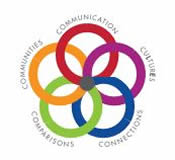World Languages
The five "C" goal area (Communication, Cultures, Connections, Comparisons, and Communities) of World-Readiness Standards for Learning Languages
Northwest Education Services' World Languages Learning Community shares a common vision of creating lifelong learners through World Languages education.
Our collaboration provides the opportunity to learn from one another, align procedures and practices, monitor the effectiveness of our instruction by developing and sharing results from common assessment practices, and sustain mutual accountability for all students’ learning.
Language and communication are at the heart of the human experience. The United States must educate students who are linguistically and culturally equipped to communicate successfully in a pluralistic American society and abroad. This imperative envisions a future in which ALL students will develop and maintain proficiency in English and at least one other language, modern or classical. Children who come to school from non-English backgrounds should also have opportunities to develop further proficiencies in their first language.
Statement of Philosophy of Standards for Foreign Language Learning from The National Standards Collaborative Board. (2015). World-Readiness Standards for Learning Languages. 4th ed. Alexandria, VA: Author.
Instructional Resources
The instructional resources site linked below is designed to help support World Language educators and administrators in the region. If you are looking for specific information and cannot find it in the resources site, please contact us and we will get back with you as soon as possible.

